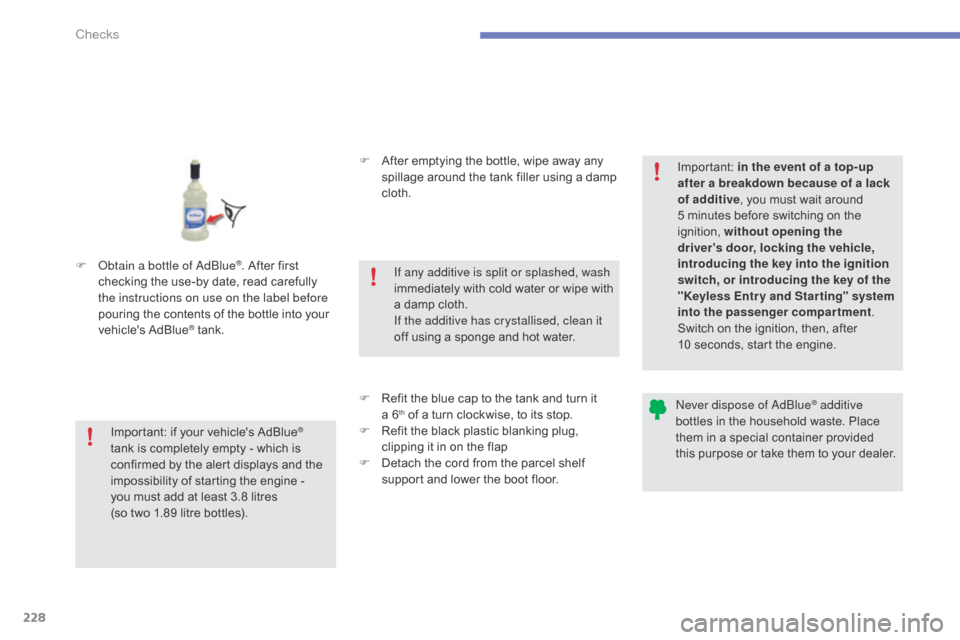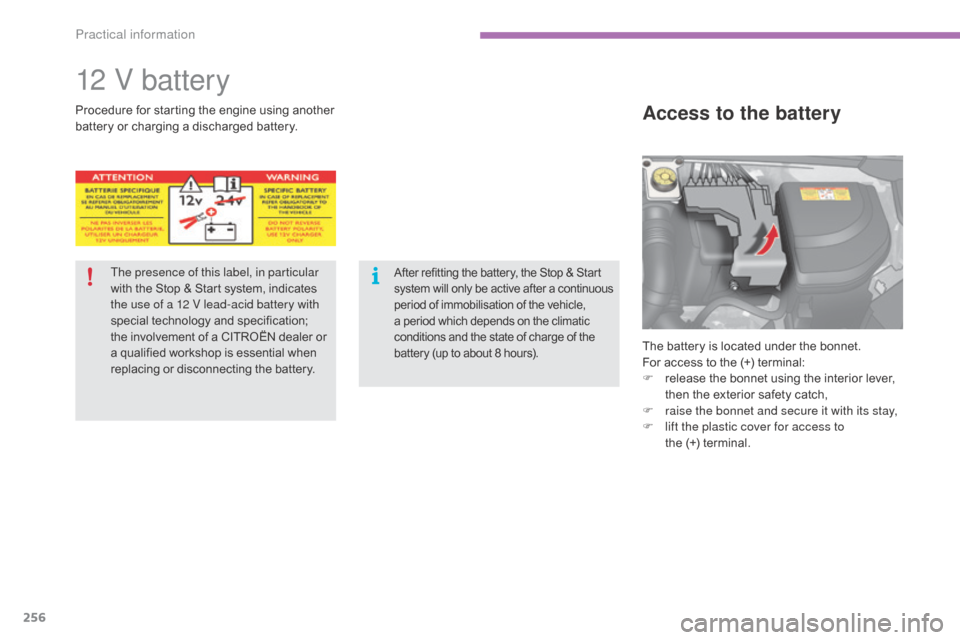2015 Citroen C4 stop start
[x] Cancel search: stop startPage 230 of 494

228
C4-2_en_Chap10_verification_ed01-2015
C4-2_en_Chap10_verification_ed01-2015
F obtain a bottle of adbl ue®. After first c
hecking
the
use-by
date,
read carefully
t
he instructions on use on the label before
pouring
the
contents
of
the bottle into your
v
ehicle's
Ad
Blue
® tank. F
A
fter emptying the bottle, wipe away any
s
pillage around the tank filler using a damp
c
loth.
F
R
efit the blue cap to the tank and turn it
a
6
th of a turn clockwise, to its stop.
F
R
efit the black plastic blanking plug,
c
lipping it in on the flap
F
D
etach the cord from the parcel shelf
s
upport and lower the boot floor.
Important:
if
your
vehicle's
AdBlue®
tank
is
completely
empty
-
which
is
c
onfirmed
by
the
alert
displays
and
the
i
mpossibility
of
starting
the
engine
-
you
must
add
at
least
3.8 litres
(so
two
1.89
litre
bottles). If any additive is split or splashed, wash
immediately
w
ith
c
old
w
ater
o
r
w
ipe
w
ith
a
damp cloth.
If the additive has crystallised, clean it
off using a sponge and hot water.Important:
i
n the event of a top-up
after a breakdown because of a lack
of additive , you must wait around
5 minutes before switching on the
ig
nition,
w
ithout opening the
driver's door, locking the vehicle,
introducing the key into the ignition
switch, or introducing the key of the
"Keyless Entr y and Star ting" system
into the passenger compartment .
Switch on the ignition, then, after
10 seconds, start the engine.
ne
ver dispose of a
dbl
ue
® additive
bottles
in
the
household
waste. Place
t
hem
in
a
special
container provided
t
his
p
urpose
o
r
t
ake
t
hem
t
o
y
our
d
ealer.
Checks
Page 258 of 494

256
C4-2_en_Chap11_info-pratique_ed01-2015
C4-2_en_Chap11_info-pratique_ed01-2015
12 V battery
The battery is located under the bonnet.
For access to the (+) terminal:
F
r
elease the bonnet using the interior lever,
t
hen the exterior safety catch,
F
r
aise the bonnet and secure it with its stay,
F
l
ift the plastic cover for access to
the (+)
terminal.
Access to the batteryProcedure for starting the engine u sing another b
attery or charging a discharged battery.
The presence of this label, in particular
with
the Stop & Start system, indicates
t
he use of a 12 V lead-acid battery with
special
t
echnology
a
nd
s
pecification;
t
he involvement of a CITROËN dealer or
a
qualified workshop is essential when
r
eplacing or disconnecting the battery.
After refitting the battery, the Stop & Start system w ill o nly b e a ctive a fter a c ontinuous p
eriod of immobilisation of the vehicle,
a
period which depends on the climatic
c
onditions and the state of charge of the
b
attery (up to about 8 hours).
Practical information
Page 261 of 494

259
C4-2_en_Chap11_info-pratique_ed01-2015
C4-2_en_Chap11_info-pratique_ed01-2015
Charging the battery using
a battery charger
F Disconnect the battery from the vehicle.
F F ollow the instructions for use provided by
the
manufacturer of the charger.
F
C
onnect the battery starting with the
n
egative terminal (-).
F
C
heck that the terminals and connectors
a
re clean. If they are covered
w
ith
s
ulphate
(
whitish or greenish deposit), remove them
a
nd clean them.
Reinitialisation after
reconnection
after any reconnection of the battery, switch on
the ignition and wait at least one minute before
s
tarting, to allow time for the initialisation of the
e
lectronic systems.
By
referring to the corresponding sections, you
s
hould set or initialise the following systems
y
ourself:
-
o
ne-touch electric windows,
-
t
ime and date,
-
a
udio and navigation system settings.
Check
that no alert message or warning lamp
c
omes on after switching on the ignition.
However,
if minor problems persist after
c
arrying out these operations, contact a
C
ITROËN dealer or a qualified workshop.
Reconnecting the (+) cable
F Position the open clamp E of the cable on
the positive post (+) of the battery.
F
P
ress vertically on the clamp E to position
it
correctly on the battery.
F
L
ock the clamp by spreading the
p
ositioning lug and then lowering the tab D.
Disconnecting the (+) cable
F Raise the locking tab D fully to release the
cable t erminal c lamp E.
D
o not apply excessive force on the
t
ab as locking will not be possible if the
c
lamp is not positioned correctly; start
t
he procedure again. With Stop & Start, the battery does not
have
to be disconnected for charging.
11
Practical information
Page 262 of 494

260
C4-2_en_Chap11_info-pratique_ed01-2015
C4-2_en_Chap11_info-pratique_ed01-2015
Load reduction modeE nergy ec onomy m ode
Switching to economy mode
Once this period has elapsed, a message a
ppears in the screen indicating that the
v
ehicle has switched to economy mode and the
a
ctive functions are put on standby.
Exiting economy mode
These functions are reactivated automatically the next time the vehicle is driven.
F
I
n order to resume the use of these functions
i
mmediately, start the engine and let it run for a
f
ew
m
inutes.
The
time available to you will then be double
t
he period for which the engine is left running.
H
owever, this period will always be between
five
and thirty minutes.
System
which
manages
the
use
of
certain
f
unctions
according
to
the
level
of
charge
r
emaining
in
the
battery.
When
the
vehicle
is
being
driven,
the
load
r
eduction
function
temporarily
deactivates
c
ertain
functions,
such
as
the
air
conditioning,
t
he
heated
rear
screen...
The deactivated functions are reactivated
automatically
as
soon
as
conditions
permit. System
which
manages
the
period
of
use
of
certain
functions to conserve a sufficient level of
c
harge
in
the
battery.
After
the
engine
has
stopped,
you
can
still
use
functions such as the audio equipment, windscreen
w
ipers,
dipped
beam
headlamps,
courtesy
lamps,
etc. for
a m
aximum
c
ombined
p
eriod
o
f
t
hirty
m
inutes.
A flat battery prevents the engine from
s
tarting (refer to the corresponding
par
agraph).
This
period
may
be
greatly
reduced
if
t
he
battery
is
not
fully
charged.
If
the
telephone
is
being
used
at
the
s
ame
time
on
the
navigation
system,
i
t
w
ill
be
interrupted
after
1
0
m
inutes.
Practical information
Page 278 of 494

276
C4-2_en_Chap12_caracteristique_ed01-2015
C4-2_en_Chap12_caracteristique_ed01-2015
* The maximum power corresponds to the value type-approved on a test bed, under conditions defined in European legislation (Directive 1999/99/EC).
. ../S:
model fitted with Stop & Start.
.../1: model
fitted with low rolling resistance tyres.
.../2:
model fitted with very low rolling resistance tyres.
Petrol engine
Puretech 130 S&STHP 155
Gearbox Manual
(6- speed) EAT6 Automatic
(6- speed) ETG6 Electronic
(6- speed)
Model code:
NC... HNYM/S
HNYM/1S HNY T/S
HNY T/1S
HNY T/2S 5FV8/P
Cubic capacity (cc)
1 199
1 598
Bore x stroke (mm)
70 x 90.5
77 x 85.8
Max power*: EU standard (kW)
96115
Max power engine speed (rpm)
5 5006 000
Max torque: EU standard (Nm)
230240
Max torque engine speed (rpm)
1 750
1 400
Fuel UnleadedUnleaded
Catalytic converter Ye sYe s
Engine oil capacity (in litres) 3.54,25
Technical data
Page 281 of 494

279
C4-2_en_Chap12_caracteristique_ed01-2015
C4-2_en_Chap12_caracteristique_ed01-2015
* The maximum power corresponds to the value type-approved on a test bed, under conditions defined in European legislation (Directive 1999/99/EC).
Diesel engines and gearboxes
.../S: model fitted with Stop & Start.
.../1: model fitted with low rolling resistance tyres (for example: MICHELIN Energy Saver).
.../2:
model fitted with very low rolling resistance tyres.
Diesel engine
HDi 90HDi 90 FAP BlueHDi 100 e-HDi 115
Gearbox Manual
(5 - speed) Manual
(5 - speed) Manual
(5 - speed) Manual
(6- speed) ETG6
Electronic (6- speed)
Model code:
NC... 9HJC
9HJC/1 9HP0BHY6
BHY6/1
BHY6/2S 9HD8/S
9HD8/1S
9HD8/2S 9HD8/1PS
9HD8/ 2PS
Cubic capacity (cc)
1 560
1 560
1 560
1 560
Bore x stroke (mm)
75 x 88.3 75 x 88.3 75 x 88.3
75 x 88.3
Max power*: EU standard (kW)
6868 73 84
Max power engine speed (rpm)
4 0004 000 3 750
3 600
Max torque: EU standard (Nm)
230230254 270
Max torque engine speed (rpm)
1 750
1 750
1 750
1 750
Fuel
die
sel
die
sel
die
sel
die
sel
Catalytic converter Ye sYe sYe s Ye s
Particle filter (FAP)
n
o
Ye s Ye s Ye s
Engine oil capacity (in litres) 3.753.753.75 3.75
12
Technical data
Page 282 of 494

280
C4-2_en_Chap12_caracteristique_ed01-2015
C4-2_en_Chap12_caracteristique_ed01-2015
* The maximum power corresponds to the value type-approved on a test bed, under conditions defined in European legislation (Directive 1999/99/EC).
. ../S:
model fitted with Stop & Start.
.../1:
model fitted with low rolling resistance tyres (for example: MICHELIN Energy Saver).
.../2:
model fitted with very low rolling resistance tyres.
Diesel engine
BlueHDi 115BlueHDi 120HDi 150 FAPBlueHDi 150
Gearbox Manual
(6- speed) E AT 6
Automatic (6- speed) Manual
(6- speed) E AT 6
Automatic (6- speed) Manual
(6- speed) E AT 6
Automatic (6- speed)
Model code:
NC... BHXM/S
BHXM/1S
BHXM/2S BHX T/S
BHX T/1S
BHX T/2S BHZM/S
BHZM/1S
BHZM/2S BHZT/S
BHZ T/1S
BHZT/2S RHE8
RHE8/1 AHRM/S
AHRM/1S
AHRM/2S
Cubic capacity (cc)
1 560
1 560
1 997
1 997
Bore x stroke (mm)
75 x 88.3
75 x 88.3
85 x 88 85 x 88
Max power*: EU standard (kW)
858811 011 0
Max power engine speed (rpm)
3 500
3 500
3 750
4 000
Max torque: EU standard (Nm)
300300340370
Max torque engine speed (rpm)
1 750
1 750
2 000 2 000
Fuel
die
sel
die
sel
die
sel
die
sel
Catalytic converter Ye sYe sYe sYe s
Particle filter (FAP)
Ye sYe sYe sYe s
Engine oil capacity (in litres) 3.753.755.256 .1
Technical data
Page 315 of 494

313
C4-2_en_Chap13b_SMEGplus_ed01-2015
C4-2_en_Chap13b_SMEGplus_ed01-2015
Level 1Level 2 Level 3 Comments
Navigation Settings
Navigation Enter destination
Display recent destinations.
Calculatory criteria
Fastest
Choose the navigation criteria.
The map displays the route chosen according to these
criteria.
Shortest
Time/distance
Ecological
Tolls
Ferries
Strict - Close
Show
route on map
Display the map and start navigation.
ConfirmSave the options.
SaveSave the current address.
Stop navigationDelete the navigation information.
VoiceChoose the volume for voice and announcement of street names.
DiversionDetour from your initial route by a certain distance.
Navigation
Display in text mode.
Zoom in.
Zoom
out.
Display
in full screen mode.
Use
the arrows to move the map.
Switch
to 2D map.